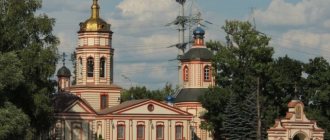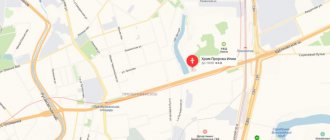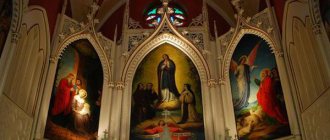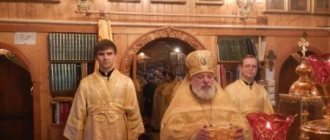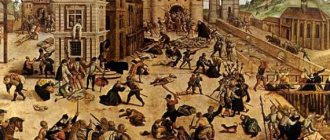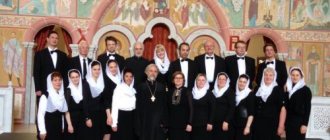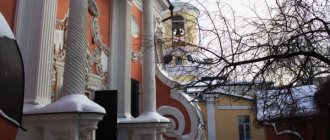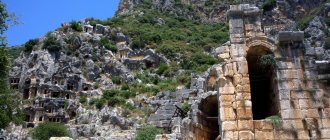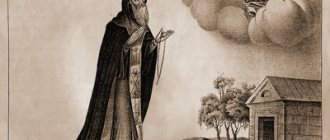Before the revolution, the Church of the Exaltation of the Holy Cross on Vrezhka was one of the richest in Moscow. Patriarch Tikhon and Metropolitan Seraphim (Chichagov) served here. And among the parishioners there were many outstanding personalities.
Such famous rulers as Metropolitan Philaret (Drozdov), Metropolitan Seraphim (Chichagov), who did a lot to glorify Seraphim of Sarov, and Patriarch Tikhon of Moscow and All Rus' served within the walls of the Church of the Exaltation of the Cross.
Even before the revolution, the church on Chisty Vrazhek was one of the richest in Moscow. After the revolution, the new government, which took up arms against the Church, began confiscating valuables from churches. It is known that in 1918, more than four hundred pounds (!) of silver utensils were carried away from the Vozdvizhenskaya Church. Three years later, another “8 spools of gold and 16 poods 3 pounds of silver” were confiscated from the temple. True, the church itself was not closed then. Patriarch Tikhon served the Divine Liturgy here in July 1921, and in January 1924 he celebrated an all-night vigil and liturgy the next morning.
Consecration of the temple
The consecration ceremony took place in Kazan on one of the last days of August 2008. The mayor of the city, I.R. Metshin, and the Chairman of the State Council of Tatarstan, F.Kh. Mukhametshin, took part in it. The solemn mass was also attended by the head of the College of Cardinals, Angelo Sodano, and invited persons from Poland, Portugal, and the United States. The cardinal emphasized in his sermon that the new temple will be a reminder of the glorification of the Holy Cross. Currently, the rector of the church is Father Diogenes Urquize.
Bishop Clemens Pickel noted the importance of the appearance of a Catholic church in the city and called this event great for the diocese. He wished the temple to avoid the sad fate of its predecessor and expressed the hope that it would always serve the glorification of Christ. The Ordinary wished the believers who would pray within the walls of the church joy and courage, a sense of closeness to God.
Chairman of the State Council of the Republic of Tatarstan Mukhametshin, who spoke at the ceremony, highly appreciated the fact of the appearance of a Catholic church in the capital of Tatarstan. He called this event the restoration of justice in relation not only to the Kazan community, but also to Catholics throughout the Volga region. The mayor of Kazan, I.R. Metshin, recalled the return of the icon of the Kazan Mother of God by Pope John Paul II in 2005. After this, life in the region changed for the better, and many glorious pages were written in the chronicle of the city and the Republic.
AT THE FOOT
The Vysoko-Petrovsky Monastery is perhaps the most dear place in Moscow for me. I have been going to Christmas readings for decades now - and here, in the Department of Religious Education and Catechesis, they warmly welcome me, issue accreditation, and then some sections and round tables are held here. In general, I feel at home on Petrovka, and I often came here just for fun, not only at the Readings. You will get off at the Tverskaya metro station, walk along Strastnoy Boulevard, sit on a bench, admiring the domes of such Russian churches as if floating into the air from behind the fortress monastery walls - the Bogolyubskaya Icon of the Mother of God, St. Peter of Moscow, St. Sergius of Radonezh... In one of them certainly service. I knew that a little further - around the corner of the fortress wall - there was another temple of St. Sergius, but for some reason I never went there. Maybe the second name – “in the Wrens” – frightened him off? Or rather, was there such completeness that there was much more holiness? But, as it turned out, it was there that for me, a northerner and a White Sea resident, was the most popular place. Because this small temple houses the largest reliquary in the Eastern and Western Churches, which consecrated the White Sea coast and the entire Russian North for three centuries.
Temple of St. Sergius of Radonezh in Krapivniki
The temple is surrounded on three sides by ancient buildings, the walls of which are decorated with some kind of oriental, Mohammedan ornament. Like Constantinople, besieged by the Turks. I enter under the church vaults. Immediately at the entrance one is greeted by a tall Cross, which at first was mistaken for Golgotha. No, he is the one - Kiysky, from an island in the White Sea.
“Immediately at the entrance you are greeted by a tall Cross - Kiysky, from an island in the White Sea”
As the story goes, in 1639, “in a small boat with a certain Christian,” Hieromonk Nikon, the future Patriarch of Moscow, sailed by sea from the Anzersky monastery and almost drowned from the great excitement of the sea, but, “trusting in the power of the Life-giving Cross,” he was saved and washed up by the waves to the island in front of the Onega mouth. Having stepped onto the granite firmament, he asked: “What is this island? (Whose island is this?)” But since the island was “empty, and unsuitable for habitants, for everything is bare stone,” it didn’t even have a name. Then Nikon said: “Let this island be called Kiy.”
In memory of the rescue, Nikon erected a Cross on the island and after a while asked Tsar Alexei Mikhailovich to grant him a charter that would allow “on that island where Nikon erected the honorable Cross, to build a church and a monastery.” This is how the Cross Monastery appeared on the White Sea. In gratitude for permission to open it, Nikon decided to build and present to the king and the entire royal family a cypress cross, which he “decorated with silver, gold and precious stones, and inside it he placed up to 300 particles of holy relics with the blood of various holy martyrs and with particles of revered Palestinian stones.” Formally, it was a gift to the Tsar, but the great shrine did not remain in Moscow - Nikon soon moved it to the Onega Cross Monastery, on Kiy Island. There, on the White Sea, she remained until 1930.
I venerate myself at the foot of the Cross. I’m trying to make out the Church Slavonic script on a metal tablet compiled by Nikon: “Under the power of the Blessed and Christ-loving Great Sovereign Tsar and Grand Duke Alexy Mikhailovich and all Great and Little and White Russia, the Autocrat and other states of the Sovereign and Possessor... from the honest cypress tree... Christ God! Have mercy and save my soul by the power of the Honest and Life-Giving Cross and the saints for the sake of prayers, whose relics are enshrined in this Cross. From the incarnation of the Word of God 1656, and from the creation of the world 7164 years, August on the first day.” On the Cross there are many metal icons of saints whose relics are enclosed here. I'm being baptized...
Icon “Kiya Cross with Those Awaiting”, painted in 1667 by Bogdan Saltanov. Left: Emperor Constantine, Tsar Alexei Mikhailovich, Patriarch Nikon. Right: Empress Elena, Tsarina Maria Ilyinichna
While waiting for the abbot to arrive, I walk around the entire temple. Worshipers stand in front of two ancient icons - the Theodore Mother of God and St. Sergius of Radonezh, with a particle of his relics. The monk blesses with two fingers - apparently an image of an Old Believer letter. The abbot appears. People line up to get their issues resolved. Then Archpriest Alexander Abramov goes to the chapel, from where the sound of a hammer is heard - work is underway on a new iconostasis. Having freed himself, he invites you to the refectory, for which the parish has been allocated premises in one of the “Mohammedan” buildings.
From the history of the Catholic community of Kazan
The history of the community dates back to the 18th century, when Catholics from among the Germans and Baltic nobles appeared in the city. After Poland annexed Russia, the Catholic population grew. The parish was officially registered in 1835, but it did not have its own premises for services. Masses were held in various buildings, most often not adapted for these purposes.
In the mid-50s of the XIX century. Priest Galimsky turned to the authorities for permission to build a church. The request was granted, but the condition was that the architecture of the building and the exterior decoration should be simple, without pronounced features characteristic of Catalystism. In those days in the Russian Empire, similar requirements were imposed on any non-Orthodox religious buildings. Thus, the original design of the building in the Gothic style was not useful; The temple was built in the spirit of classicism. And only the tall windows with a semicircular ending somewhat distinguished the building from neighboring buildings. The church was consecrated in 1858, and a year later an ark with a piece of the Life-Giving Cross arrived from Rome.
In the period 1905-1908. The temple was rebuilt and the area was increased. After the arrival of the Bolsheviks, services continued until 1927, then the temple was closed. The church premises were used for many years for other purposes; they housed university lecture halls. In 1995, the Catholic parish continued to exist, but the church building was not returned to it, but a site was allocated for construction.
Schedule of services
Services are not held on Mondays. On other days, you can follow the following schedule:
- Tuesday - Thursday : 18:30, service in Russian.
- Friday : 18:30, in Latin.
- Saturday : 17:00, in Russian. At 18:00 the Holy Sacrament is adored.
- Sunday : 09:00 - in English (except for the summer season), 11:00 and 18:00 - in Russian.
The temple can be visited every day from 10:00 to 19:00, break from 13:00 to 15:00 (except Sundays). You can follow changes in the schedule of services on the official website of the Roman Catholic Church of Kazan or in the official VKontakte group of the Catholic Parish of Kazan.
© Nomad
What does the temple look like today
In 2008, parishioners celebrated the sesquicentennial anniversary of the consecration of the first Catholic church in Kazan. Construction of the new building began in 2005. Its appearance is almost identical to the appearance of the church, nationalized in the first years of Soviet power. The architect stuck to the old project as much as possible. As a result, the church has a cruciform shape, its total area is over 1800 square meters. m. On the main facade there is a portico with four columns, on the sides there are two bell towers.
The interior of the church is decorated with white granite, and the altar and pulpit are made of the same stone. Between the nave and the altar there is a wooden cross, more than four meters high, on both sides of which there are statues of saints. The temple has an organ made by Italian craftsmen. In addition to the temple part, the building has administration premises. Services and masses are held in three languages. The parish becomes a place of high spirituality and culture for people of the Catholic faith.
Website: kazan.dscs.ru
Address: Ostrovsky street 73, Kazan, Republic of Tatarstan, Russia.
Location map:
| ← Rotunda on Peterburgskaya Street | Palace of Team Sports "Basket Hall" → |
Beyond loss
“Meanwhile, the deed was done, and now every Muscovite and guest of the capital can venerate the great shrine in our church,” Father Alexander continues the story. – The Kiya Cross is the most significant reliquary existing in both the Eastern and Western Churches. It contains particles of all the relics that were kept in the Patriarchal Palace, in the Terem Chamber - in general, were at the disposal of the Russian Patriarch.
It is noteworthy that the particles of the relics in the Cross are located openly, in small niches. They are filled with wax mastic - a mixture of wax with various incense, similar to that used for the consecration of altars. You've probably seen it in photographs - it is poured into the corners of the throne in the form of a red-hot mass. And so they put the particles into such molten wax mastic, it enveloped them, and then they were simply inserted into the recesses in the Cross, with icons attached next to them, which made it clear whose relics they were. It is known that Nikon ordered icons from the court artist of Tsar Alexei Mikhailovich and the chief master of the Armory, Bogdan Saltanov, whose real name is Astvatsatur, that is, “given by God.” He was an Armenian, originally from Persia. But it is clear that he was not the only one who worked on the icons for the Cross - they were made by different masters and in different iconographic traditions. For example, the martyr Christopher is depicted in an earlier, medieval tradition - with the head of a dog.
Particles of relics in the Cross are located openly, in small niches
– In my opinion, there are less than three hundred icons on the Cross.
– Some of the relics were enclosed without icons. In addition, under the Bolsheviks, the Cross received a loss of gold, which covered the reverse side - and there may also have been particles of relics there.
– Overall, how much has been lost?
– One hundred particles of holy relics remained in the Cross, but about two hundred were missing. What was in the crosshairs was also lost. Shrines characteristic of the seventeenth century were installed there - the milk of the Mother of God, the skin of the Apostle Paul, and so on.
– Usually Catholics had such relics. Under Nikon, European influence was probably significant?
– Undoubtedly, at that time there were some Western trends, but as for the particles of relics, this is what came to the Russian Church from Byzantium, from the Holy Land from the very first times of its existence, that is, long before the seventeenth century.
It should be noted that the Cross suffered losses not only in Soviet times. During the Crimean War he had to be evacuated from Kiy Island to Solovki. After the war, as they wrote in the Arkhangelsk Diocesan Gazette, a commission examined the Solovetsky Monastery and described the damage caused by bombardment from English ships. And when examining the iconostasis of the main temple, into which the Cross was inserted, I found losses in it. Maybe something fell out during the shaking of the shelled building, maybe it happened during transportation - the details were not reported.
– Having lost two-thirds of the particles of relics embedded in it, the Kiy Cross ceased to be the largest reliquary?
– It is still, in theory, our biggest. And then there was simply nothing even close. And the point here is not only in the number of particles of relics. Nowadays we very rarely have such haphazard boxes with relics. Everything that the rector or bishop has is usually collected in separate shrines. Moreover, what happened to be at hand, as if by chance. But here there was a plan, its own iconographic program, which we still cannot understand. Not just relics collected together, but a real reliquary.
– Are you talking about the order of arrangement of particles?
- Yes, about their order. The arrangement of particles does not go in alphabetical order, does not go according to the ranks of certain types of holiness, that is, the venerables, saints, and so on are not grouped separately. But there is undoubtedly some kind of plan there. Many researchers are working to establish it.
Shrines of the Kiev Cross
-pointed
stars • I
Stone of the Holy Sepulcher •
III
Stone from the cave where the Lord fasted for 40 days •
VI
Stone from the cave where Christ was born •
VIII
Stone of the Sepulcher of the Blessed Virgin Mary •
IX
Stone from the cave where John the Baptist prayed •
XIV
Stone from the cave where John the Baptist hid from Herod •
XV
Stone from the “meal where Abraham treated the Holy Trinity” •
XVI
Stone, part of the rod of Moses, “with which he cut off the Red Sea” •
II, IV, V, VII, X, XI, XII, XIII
Stones not inscribed
Icons and relics of saints
- Great Martyr George the Victorious
- Martyr Christopher
- Martyr Tryphon of Apamea, Nicaea
- Great Martyr Procopius of Caesarea (Palestinian)
- Great Martyr Demetrius of Thessaloniki
- Great Martyr Nikita of Goth, Constantinople
- Great Martyr Mercury of Caesarea (Cappadocia)
- Great Martyr and Healer Panteleimon
- Martyr Anastasius of Aquileia, Salonsky
- Prophet Daniel
- Equal to the Apostles Tsar Constantine
- Apostle and Evangelist Matthew, called Levi
- Apostle Andrew the First-Called
- Prophet, Forerunner and Baptist of the Lord John
- Apostle Paul
- The icon is lost
- Great Martyr Jacob the Persian
- Great Martyr Theodore Stratelates, Heraclean
- Saint Jonah, Metropolitan of Moscow and All Rus'
- Hieromartyr Epherius, Bishop of Chersonesos
- Hieromartyr Cyprian, Bishop of Carthage
- Reverend Alexy, man of God
- Saint Peter of Moscow, Metropolitan of Kiev
- Hieromartyr Theogenes (Fiogenes), Bishop of Paria
- Saint Nektarios, Patriarch of Constantinople
- Hieromartyr Clement, Bishop of Ancyra
- Hieromartyr Peter, Archbishop of Alexandria
- Saint Gregory, Bishop of Nyssa
- Saint Spyridon, Bishop of Trimifuntsky
- Saint Basil the Great, Archbishop of Caesarea in Cappadocia
- Saint John Chrysostom, Archbishop of Constantinople
- Apostle Titus of the 70, Bishop of Crete
- Apostle Stephen from the age of 70, first martyr, archdeacon
- Apostle of the 70 Barnabas (Josiah), Bishop of Milan
- Apostle Thomas Didymus (Gemini)
- Apostle of the 70 and Evangelist Mark
- Righteous Jacob, brother of the Lord according to the flesh
- Apostle of the 70 and Evangelist Luke
- Apostle Timothy of the 70, Bishop of Ephesus
- Righteous Lazarus of the Four Days, friend of God, Bishop of Crete
- Apostle James Zebedee
- Saint Gregory the Theologian, Archbishop of Constantinople
- Hieromartyr Ignatius the God-Bearer, Bishop of Antioch
- Saint John the Merciful, Patriarch of Alexandria
- Hieromartyr Basil, Presbyter of Ancyra
- Saint Epiphanius, Bishop of Cyprus
- Hieromartyr Akepsim, Bishop of Naesson
- Hieromartyr Ermolai, Presbyter of Nicomedia
- Saint Gregory Palamas, Archbishop of Thessalonica (Thessalonian)
- Saint Andrew, Archbishop of Crete
- Hieromartyr Athenogenes, Bishop of Pidakhfoi (Sevastia)
- Saint Philip, Metropolitan of Moscow and All Rus'
- Saint Alexy, Metropolitan of Moscow, Wonderworker of All Rus'
- Saint Gury, Archbishop of Kazan
- Great Martyr Theodore Tiron
- Martyr Eustratius of Sebaste, military leader
- The icon is lost
- Martyr Callinicus of Caesarea (Bifyn)
- Martyr Cyric of Tarsus
- Martyr Callistratus of Byzantium
- Martyr Mamant of Caesarea (Cappadocia)
- Martyr and unmercenary Cosmas of Rome
- Hieromartyr Aviv, Deacon of Edessa
- Hieromartyr Euplus, Archdeacon of Catania (Sicilian)
- Martyr Lucian of Dyrrachium
- Martyr Neophyte of Nicaea
- Martyr and unmercenary Damian of Rome
- Martyr Auxentius of Sebaste, Arabia
- Great Martyr Barbara of Iliopol
- Venerable Anthony the Great, Egyptian
- Venerable Euthymius the Great
- Great Martyr Euphemia of All Praise, Chalcedonian
- Venerable John of Damascus
- Venerable Ephraim the Syrian, Edessa
- Venerable Martyr and Confessor Stephen the New
- Venerable Gregory Dekapolite
- Venerable Pimen the Great
- Venerable Theodore Sikeot, Bishop of Anastasioupol
- Martyr and unmercenary Cyrus of Alexandria
- Rev. George Hozevit
- Rev. Mikhail Malein
- Venerable Nikita, Confessor of Constantinople
- Martyr and unmercenary Cosmas of Arabia, Cilicia
- Venerable Sergius of Radonezh
- Saint Jonah, Archbishop of Novgorod
- Venerable Anthony the Roman, Novgorod
- Righteous Jacob Borovichsky, Novgorod
- Venerable Savva of Storozhevsky, Abbot of Zvenigorod
- Venerable Euthymius of Suzdal
- Blessed Prince Alexander Nevsky
- Blessed Prince Roman Uglichsky
- Great Martyr Marina (Margarita) of Antioch
- Martyr Irene of Aquileia
- Venerable Martyr Anastasia of Rome, Thessalonian (Thessalonian)
- Blessed Prince Vladimir Yaroslavich of Novgorod
- Blessed Prince Georgy (Yuri) Vsevolodovich Vladimirsky
- Holy Blessed Grand Duchess - nun Anna Kashinskaya
- Venerable Martyr Eudokia (Iya) of Rome, Persia
- Venerable Martyr Theodosius the Virgin, Constantinople
- The icon is lost
- The icon is lost
